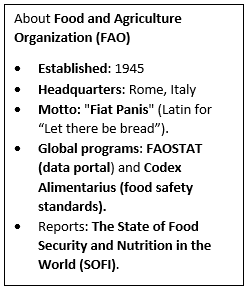Syllabus
GS 3: Inclusive growth and issues arising from it.
GS 2: Important International institutions
Context:
A new report by the Food and Agriculture Organization (FAO) says that agrifood systems can help eliminate unemployment among people aged 15 to 24 years.
More on the News
- The Status of Youth in Agrifood Systems report gives a timely and evidence-based assessment of how decent jobs and food security for youth can be achieved by transforming agrifood systems.
- It also highlights how empowered youth can become drivers of broader changes in these systems.
Key highlights from the report

- The report noted that over 20% of the world’s 1.3 billion young people are currently not in employment, education, or training (NEET).
- Addressing this unemployment, especially among those aged 20–24, could lead to a 1.4% rise in global GDP.
- Nearly 45% of this growth could come from greater youth participation in agrifood systems.
- Globally, 44% of working youth are employed in agrifood systems, compared to 38% of working adults.
- However, the share of youth in agrifood jobs has dropped from 54% in 2005.
- Nearly 85% of the world’s youth live in low- and lower-middle-income countries, where agrifood systems are vital for livelihoods.
Food Security in Affrica
- However, food insecurity among youth has risen sharply — from 16.7% to 24.4% between 2014–16 and 2021–23, especially affecting young people in Africa.
- About 395 million rural youth live in areas where agricultural productivity is expected to decline, particularly in traditional agrifood systems and sub-Saharan Africa.
Concern Raise in Report
- Climate shocks and extreme weather events caused by climate change are also a serious threat.
- The report also warned of a future labour shortage in agrifood systems due to the declining number of rural youth.
- It has urged young people to take part in food production and to adapt to rising extreme weather events.
- With the number of rural youths declining, the organisation has warned of a labour shortage in agrifood systems.
- The report urged governments to make agriculture more attractive to young people.
To address the challenges and seize the opportunities, the report emphasizes three broad strategies:
- Inquire More: Collect better data and research to understand how to make farming and food systems more youth-friendly.
- Include More: Make sure young people from all backgrounds have a say in policies and decisions that affect them.
- Invest More: Increase funding and support to create more job and business opportunities for youth in agriculture.
Adoption of Strategies will require
- Expanding Economic Opportunities: Train and support young people with the skills and tools they need to work in farming and food systems.
- Investing in Modernization: Improve infrastructure to make farming and food-related jobs more attractive to the youth.
- Facilitating Access to Resources: Create special land and credit schemes for young people to help them start and grow their farming ventures.
- Promoting Orderly Youth Migration: Provide safe and youth-friendly migration options to fill labour gaps in agriculture.
- Enhancing Digital Access: Increase access to digital tools so young farmers can improve their methods and reach better markets.

